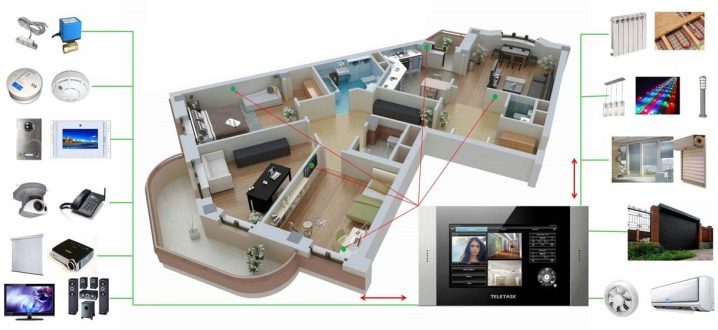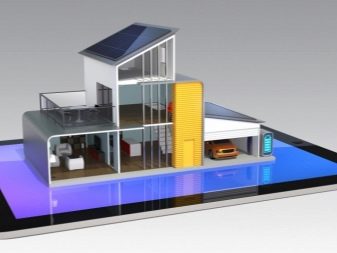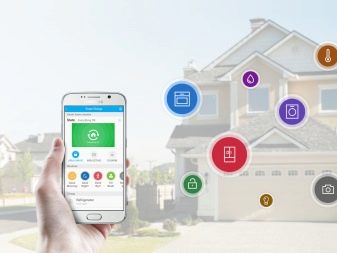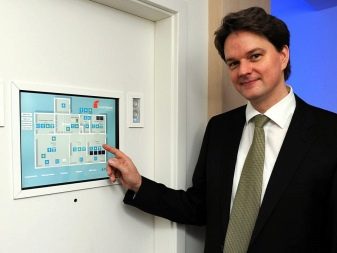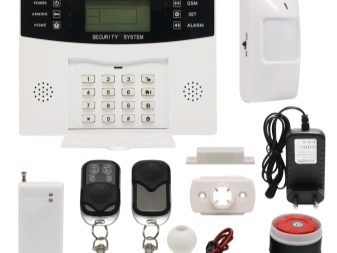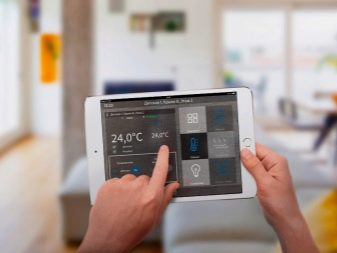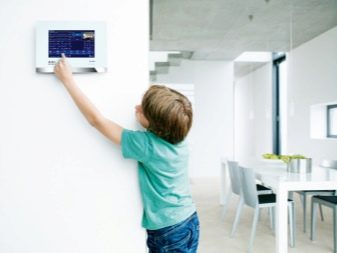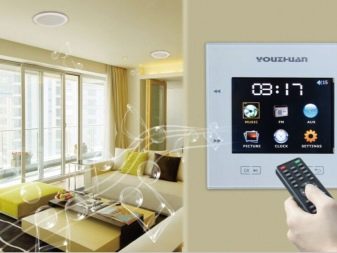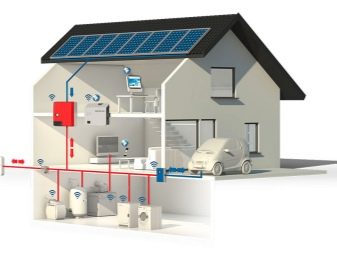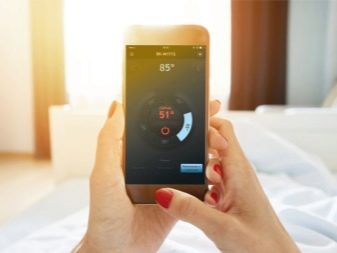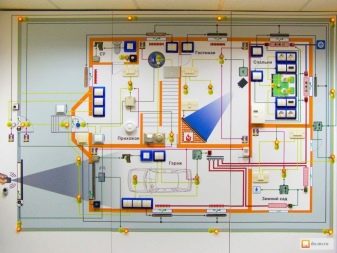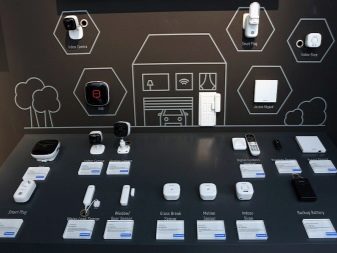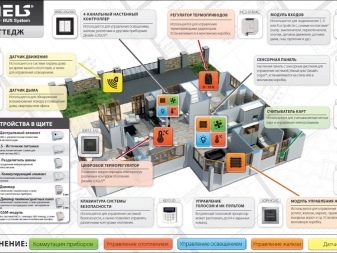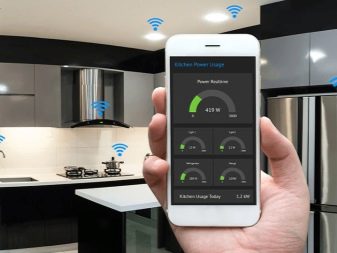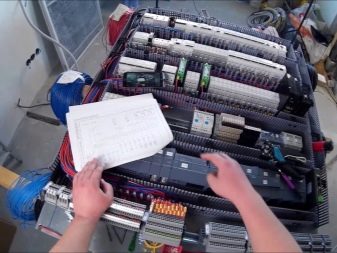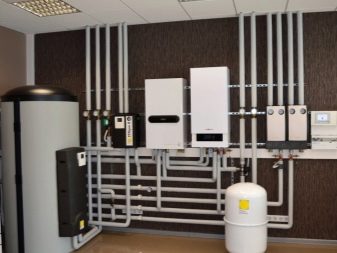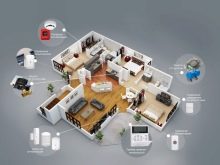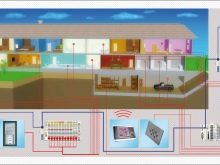"Smart Home": features, advantages and disadvantages of equipment for an apartment
“Smart home” is the comfort and safety of housing. He will save you from most household chores, help in raising children, caring for the elderly, and give a sense of complete security.
System description
The smart home system is designed for personal comfort and safety.
It represents the unified management of the following systems in the house:
- water supply;
- air conditioning;
- security and fire alarms;
- electrical engineering;
- heating;
- video surveillance.
Designed "smart home" so that all systems are interconnected, but with the ability to change settings. The owner can customize the system according to their own needs or the rhythm of life.
The invention has such features:
- wide range of options;
- saving energy, water, gas;
- the ability to control remotely via a tablet or smartphone;
Artificial intelligence controls any equipment and mechanical devices (doors, windows, gates, blinds), controls temperature, humidity, and regulates the consumption of water or electricity. Remote control allows you to turn on / off water, electrical appliances. For example, the system will be able to dial a bath or boil a kettle on your return.
Special sensors on the windows and doors when you try to open them will instantly give an alarm and send an SMS alert. In addition, in the settings you can add the function of calling the police or security services. Additional emergency sensors will alert you of a fire, gas leak or flooding. Also in the settings you can specify the number of special services that will be called in automatic mode.
With the help of a mobile application, you can monitor the condition of the house from a distance.
Setting up digital devices can solve the problem of controlling electricity or entertainment. When moving around the rooms, the intelligent control will turn off or turn on the light, switch the TV to the specified channel.All audio and video devices are integrated into a single node that distributes information. For example, if you started watching a program in a room, then, having entered the kitchen, you will continue watching from the same place.
"Smart Home" is able to automatically adjust the light in the room, taking into account not only the time of day, but also individual parameters. With this system, you can forget about the switches and enjoy the comfort of the lighting in the house and save energy. Statistics show that with the system of "smart home" electricity costs are reduced by an average of 4%.
Adjusting the air conditioning system in the apartment is a bit more complicated than in the house. Individual heating is rarely found in apartments, but special valves on radiators and a controller will allow you to maintain the optimum temperature for you.
Heated floor in the apartment gives the system more options. To ensure the desired temperature, it switches between batteries and a warm floor.
The air conditioner will help control the temperature in a hot period or, if necessary, warm the room before the heating season begins.Intelligent control will independently adjust the operation of the equipment, excluding the simultaneous operation of air conditioning and heating.
Equipment for the apartment is different from the device of a private house. The main task is comfort and safety. But the apartment does not need automation of the house adjoining site (courtyard lighting, video surveillance, watering the lawn, opening the gate for the car). There are also nuances with heating - in the apartments it is centralized, and if problems arise, it will not be possible to block the riser in a high-rise building. But this is solved with the help of sensors on the outlet from the radiator, installation of an air conditioner or a heated floor.
Security system in apartment buildings easier. Sensors are installed on the entrance doors and windows. In a private house is controlled by the territory and buildings.
Advantages and disadvantages
Of course, one cannot say that such systems are completely perfect. Consider the pros and cons of "smart home".
The advantages of the system
The comfort of living is an individual adjustment of the system to your own rhythm of life or preferences. “Smart Home” can prepare favorite coffee, turn on music or TV every morning at a certain time, while at weekends you can shift or make other settings.Even if there are several family members in the house, the “smart home” will provide comfort for everyone, freeing them from household trifles.
It is necessary to establish a “smart home” for young parents or families who care for elderly relatives. The system is able to analyze information around the clock. Special bracelets for the elderly constantly monitor their health. Certain settings will remind you to take medicine.
Parents "smart home" will also provide indispensable assistance. A hot lunch after school will be waiting for the schoolchild in the kitchen; the TV will only be shown by parents approved TV channels at certain hours. If the child leaves the house, an alert will be sent to the parents' phone.
“Smart Home” will be able to take care of pets - at a certain time in the bowl will be the right amount of food.
Security in the "smart home" is provided by a multi-level control system. The system checks all who are trying to enter. If there is no human data, an alarm is triggered and a notification is sent to the host about the attempted entry. Intellectual system owners will be able to allow or restrict access to their housing or some rooms. For example, you can prohibit an au pair with access to the owner’s office.
In private homes, surveillance is carried out outside the house, the whole territory is monitored around the clock. There is a convenient function "imitation of presence". If you plan a long vacation, the system will open and close the curtains or blinds, turn on the light in the evening.
All communications are controlled by the system. Sensors will signal leaks in pipes, electrical wiring problems, smoke or carbon monoxide.
When an emergency occurs, the “smart home” quickly prevents its further development - it closes pipes, gas or water and notifies special services and the owner.
The climate in the room is regulated by the system according to the settings. For each room you can set your own settings. The system takes into account external indicators of temperature, humidity, and immediately responds to changes, providing the parameters that were set by the owner.
Savings - the main advantage of the system. Experts say that operating costs are reduced by 30% due to artificial intelligence.
Electricity is saved in several ways:
- installation of motion sensors;
- the use of "smart lamps" and light detectors;
- full automation of climate systems.
"Smart Home" allows you to reduce the cost of electricity from 20 to 40%. The more intelligent subsystems installed, the greater the savings. Communication sensors reduce the risk of emergency situations by up to 70%.
disadvantages
Equipment for the “smart home”, installation, maintenance in the future - the pleasure is not cheap, and this is the main disadvantage of the system.
The complexity of the installation is the second drawback. Installation requires replacement of wiring, re-equipment of water supply, heating systems, replacement of windows, doors, installation of blinds or electric curtains. Also, wires will be stretched across the house to connect a variety of sensors. If instead of wires to use radio channels to control sensors, the cost of the system will increase several times. Many have a question about the safety of living in such a house. Experts claim that all materials are environmentally safe.
And the last minus is the equipment room. Power surges, power outages can disrupt the system.
For normal operation, you need to install a voltage regulator and a generator in a separate room.
The list of devices and their functions
In order for a house or apartment to function in full, you need to figure out which devices are needed for this.
Main devices:
- controller;
- communication expansion systems;
- electrical circuit switching elements;
- sensors, sensors, measuring devices;
- control devices;
- actuators.
The controller is the main element of the system. The main function is the management of all devices, and notification of the state of the house and appliances. The device can be programmed to work autonomously or be controlled via a smartphone or computer. The controller collects information from sensors about temperature, light level, humidity and regulates the operation of the heating system, lighting, air conditioning, ventilation.
Communication extension systems transmit messages to the owner. Data can be transferred by wired (Internet, USB) or wireless (Wi-Fi) method. GSM / GPRS modules notify about the state of the house via SMS.
The switching elements of the electrical circuit are responsible for the circuit / disconnection, voltage regulation. This includes the power supply, transformers, relays, converters. Elements prevent network overload and short circuit.
Sensors and sensors give a signal to the controller about the temperature in the house and outside, humidity, light level, and atmospheric pressure. Measurement devices take into account more parameters. These include water and gas meters, barometers.
Control devices are supplied. These are touch panels or remote controls with a radio. By installing a special program on a smartphone or tablet, you can manage from anywhere.
Actuators are motors, valves, locks. In motion are driven by a command from the controller. These mechanisms open or close doors, windows, gates, curtains, ventilation valves.
Separately installed weather-dependent heating automation. The main function of the kit is to ensure the operation of the heating boiler according to a certain algorithm: the temperature in the street decreases - it rises inside the house. In an apartment building, the work of automation is different by the principle of heating - if necessary, change the temperature of the controller mixes heat carriers.
Connecting the "smart home" system requires special wiring, which creates a single network and starts the work of all devices and sensors.
But a single network of electricity can be created without repair, using intelligent devices to create a wireless system.
Tips
Before installing the system "smart home" you need to decide on the wiring. If the apartment is only after repair, it is advisable to install a wireless system. It is also necessary to decide how many air conditioners and radiators there will be, think over which controls are necessary, and also take into account the parameters of the room.
In fact, the "smart home" is a set of devices that need to be properly assembled. For self-assembly will require minimal knowledge of electrics, the principles of building automatic circuits, experience programming OS. You also need to have an idea how the system algorithm works.
To help with all the questions help ready-made solutions that offer companies.
The fact that can "smart home", see the following video.

